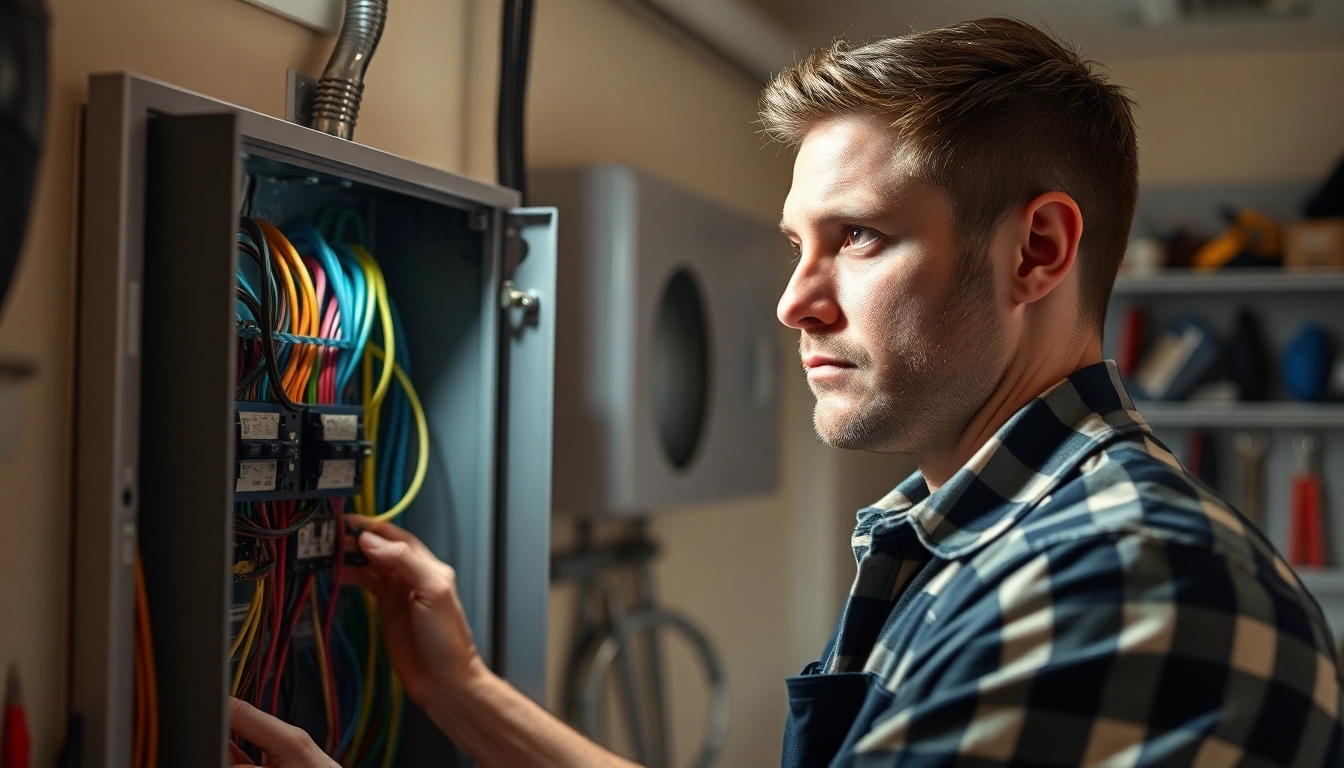Understanding Electrical Panel Upgrade Needs
When it comes to ensuring the safety and efficiency of your home’s electrical system, understanding when to consider an electrical panel upgrade is crucial. An electrical panel serves as the distribution center for all the electricity that powers your home, managing the electrical flow from the utility company and distributing it through individual circuits. Over time, the demands placed on these panels can change significantly due to increased consumption from modern appliances, home renovations, or changes in lifestyle. Herein lies the importance of recognizing the signs that indicate a necessary upgrade, as well as the benefits and myths surrounding these systems.
Signs You Need an Electrical Panel Upgrade
Identifying when your electrical panel needs an upgrade is essential for maintaining both functionality and safety in your home. Here are some common signs to watch for:
- Increased Electrical Demands: More electronics and appliances typically lead to an increased power load. If your household has adopted smart home technology or you have purchased newer, high-demand appliances, your current panel may not suffice.
- Frequent Circuit Breaker Trips: If your breakers frequently trip or fuses blow, this could indicate that your panel is overloaded and incapable of handling additional current.
- Burning Smell or Discoloration: If you ever notice a burning smell near your electrical panel or find signs of burn or arc damage, it is crucial to upgrade immediately to prevent potential fire hazards.
- Older Panels: Homes with electrical systems over 30 years old may have outdated panels, making them susceptible to inefficiencies and safety hazards compared to modern standards.
- New Additions or Renovations: Any significant remodels or additions to your home may require additional circuits and increased power, typically necessitating an upgrade in your panel.
Benefits of Upgrading Your Electrical Panel
Upgrading your electrical panel can yield several significant benefits that enhance not only the safety of your home but also its overall efficiency and adaptability:
- Increased Capacity: One of the primary advantages of an upgraded panel is the increase in electrical capacity. This means that you will be able to support additional circuits and appliances, which is especially pertinent for homes adopting electric vehicles or extensive home automation systems.
- Improved Safety: Newer panels are designed to comply with modern electrical safety standards, reducing the risk of electrical fires, shocks, and other hazards.
- Better Functionality: An upgraded panel can facilitate better functionality and distribution of electrical power, decreasing the likelihood of interruptions and improving performance of appliances.
- Increased Home Value: A modern electrical system is an attractive feature for potential home buyers. An upgrade can improve your home’s market appeal, particularly in competitive real estate markets.
- Long-term Savings: While the upfront investment in an upgrade may be substantial, the long-term savings associated with energy efficiency and increased reliability can make the upgrade cost-effective.
Common Myths about Electrical Panel Upgrades
As with many home improvement projects, misconceptions surrounding electrical panel upgrades can lead to delays or avoidance of necessary improvements. Here are a few common myths debunked:
- Myth 1: Upgrading is Too Expensive: While costs can vary depending on the scope of work, many find that the investment is necessary and can be financed, especially when considering safety and efficiency factors.
- Myth 2: All Panels Are the Same: Different homes have varying requirements based on size, number of circuits, and future electric loads. Not “all panels” can meet the same demands.
- Myth 3: DIY Installs are Safe: Attempting to upgrade your electrical panel as a DIY project can be dangerous. Proper installation requires expertise and knowledge of local codes and standards.
- Myth 4: You Can Simply Rewire: Rewiring isn’t a substitute for upgrading; an upgrade involves enhancing the capacity and technology of the entire system.
Choosing the Right Electrical Panel for Your Home
When considering an electrical panel upgrade, selecting the right panel is crucial. Various factors contribute to what might be the ideal choice for your home’s needs.
Types of Electrical Panels and Their Capacities
There are several types of electrical panels available, each offering different capacity levels and features:
- Standard Panels: Most residential homes utilize standard panels with capacities typically ranging from 100 to 200 amps. A 200 amp panel is standard for larger homes or those with multiple high-demand appliances.
- Subpanels: These are used for additional power distribution and are installed to serve a specific area or function, such as a garage or workshop.
- Smart Panels: The latest innovation in electrical panels comes with smart technology, allowing for remote management and monitoring via mobile applications, enhancing efficiency and control.
Factors Influencing Electrical Panel Selection
Choosing the right panel extends beyond just capacity. Key considerations include:
- Home Size and Structure: The number of circuits necessary largely depends on the size of your home and how it is laid out.
- Future Needs: Consideration for future upgrades is vital. Are you planning further renovations or additions? If so, a higher capacity panel may be necessary.
- Compliance with Local Codes: Each locality has specific electrical codes that any new installation must comply with, which necessitates a check before making a decision.
Regulatory Considerations Before Upgrading
Electrical upgrade projects must adhere to local, state, and national regulations to ensure safety and compliance:
- Permitting Requirements: Most jurisdictions require permits for electrical work to ensure that it meets safety regulations.
- Building Codes: Familiarize yourself with the National Electrical Code (NEC) and local amendments, as these will influence how installations must be completed.
- Inspection Processes: After installation, panels usually need to be inspected by local authorities to verify that they are compliant with all regulations before they can become operational.
Installation Process for Electrical Panel Upgrades
The process of upgrading an electrical panel involves several crucial steps to ensure the upgrade is done safely and correctly.
Preparing Your Home for the Upgrade
Preparation is key for a successful electrical panel upgrade:
- Clear the Area: Ensure the work area around the panel is accessible and clear of obstructions to allow the electrician room to work safely.
- Notify Your Utility Provider: Contact your electric utility provider to inform them of the upgrade, which may involve a temporary shutdown of power.
- Schedule Work with a Professional: It’s crucial to set a timeline with a licensed electrician who will carry out the upgrade to ensure all work is done safely and per code.
Steps Involved in Installing a New Electrical Panel
The actual installation process typically follows these key steps:
- Power Shutoff: The first step involves shutting off the power supply to the home to ensure safety during the upgrade.
- Removing Old Panel: The old panel is unmounted, and all existing wiring is carefully disconnected and documented.
- New Panel Installation: The new panel is mounted, and existing wiring is redirected into it according to the new layout and circuit needs.
- Testing Connections: Once installed, connections are tested to ensure everything is functioning correctly before the power is turned back on.
- Final Inspection: The installation should be inspected by a qualified professional to guarantee compliance with local codes.
Post-Installation Tips for Homeowners
After your electrical panel has been successfully upgraded, there are several important steps to take:
- Test Outlets and Circuits: Once power is restored, make sure to test all outlets and circuits to ensure everything is functioning smoothly.
- Review Electrical Loads: If you’ve upgraded to a higher capacity panel, take the time to distribute your electrical loads appropriately to avoid any potential overloads.
- Retain Documentation: Keep all documents from your upgrade, including any permits, inspection reports, and warranties for your new panel.
Cost Considerations for Electrical Panel Upgrades
Understanding the costs associated with upgrading your electrical panel is crucial for budgeting your project effectively.
Average Costs and What to Expect
The cost of electrical panel upgrades can vary widely based on several factors:
- Scope of Work: The extent of the upgrade required and whether it involves just the panel replacement or additional wiring or outlet installations can influence costs.
- Panel Type: Standard panels typically range from $800 to $3,000, while higher-end or smart panels may be more costly.
- Labor Costs: Labor costs can vary depending on the experience of the electrician, as well as regional pricing differences for trades.
Financing Options for Electrical Panel Upgrades
Many homeowners may seek financing options to spread the cost of an electrical panel upgrade:
- Home Improvement Loans: Several banks and credit unions offer loans specifically designed for home improvement projects.
- Credit Cards: Higher limit credit cards can provide immediate funding, but be cautious of high-interest rates.
- Personal Loans: A personal loan can also be used to finance an upgrade, often with fixed interest rates making it easy to budget.
Potential Tax Credits and Rebates
In certain jurisdictions, homeowners may qualify for tax credits or rebates that can offset the cost of an electrical panel upgrade:
- Federal and State Incentives: Some states offer energy efficiency rebates for electrical upgrades aimed at improving energy use.
- Utility Company Programs: Many utility companies provide incentives for homeowners who make energy-efficient upgrades, like panel enhancements.
- Tax Deductions: It’s advisable to check with a tax professional to explore any potential deductions based on your upgrade.
Safety and Compliance in Electrical Panel Upgrades
Ensuring safety and compliance during an electrical panel upgrade not only protects your home but also keeps your family safe from potential hazards.
Understanding Local Electrical Codes
Staying compliant with local electrical codes is paramount to ensure safety and prevent legal issues:
- Research Requirements: Take time to familiarize yourself with both local and national codes that affect electrical installations.
- Consult Professionals: Electricians are knowledgeable about the codes required for safe installations. Consulting with them is crucial.
Safety Precautions During Installation
To safeguard both your family and the workspace, follow these safety precautions:
- Use Proper Equipment: Ensure that all tools and equipment are rated for electrical work and are in good condition.
- Wear Protective Gear: Include gloves and goggles to help protect against electric shock and debris during the installation.
Long-term Maintenance for Your Electrical Panel
Once you’ve upgraded, ongoing maintenance is necessary to keep your electrical system in optimal condition:
- Regular Inspections: Schedule electrical inspections every few years to verify that your panel is functioning efficiently and safely.
- Address Problems Promptly: If you notice any issues, such as flickering lights, warmth from the panel, or strange noises, seek a professional opinion immediately.



